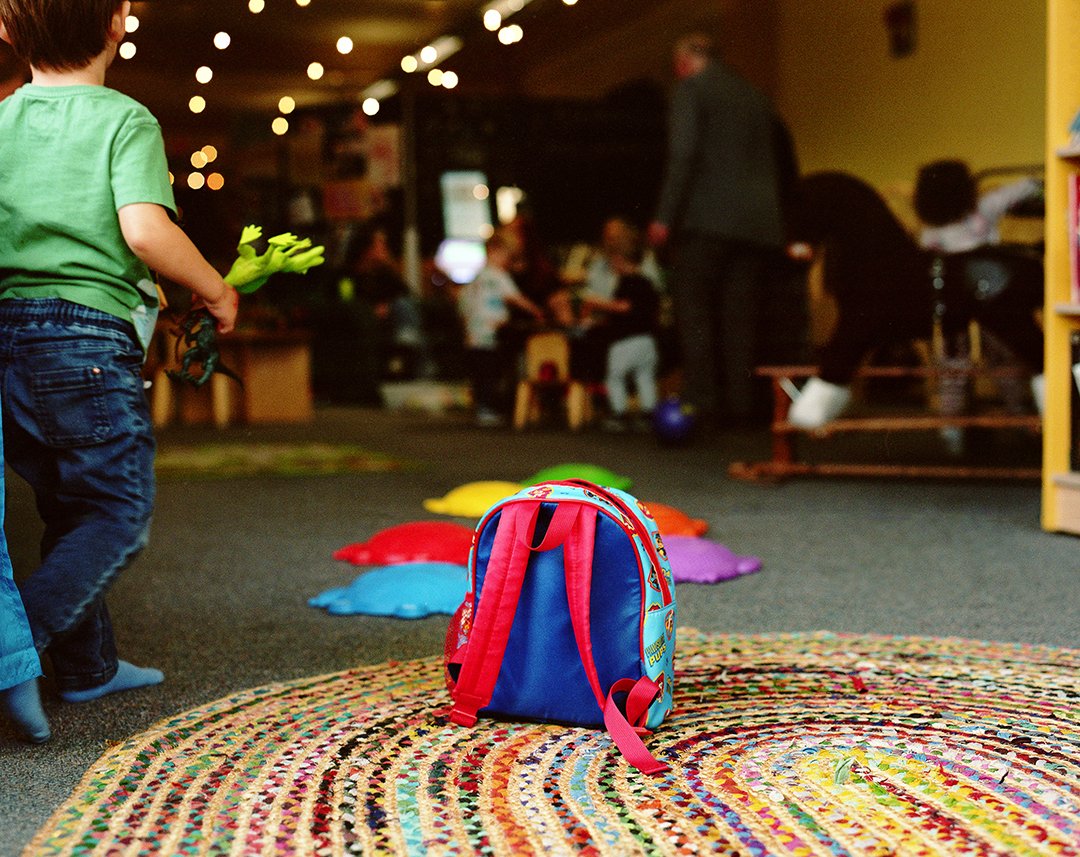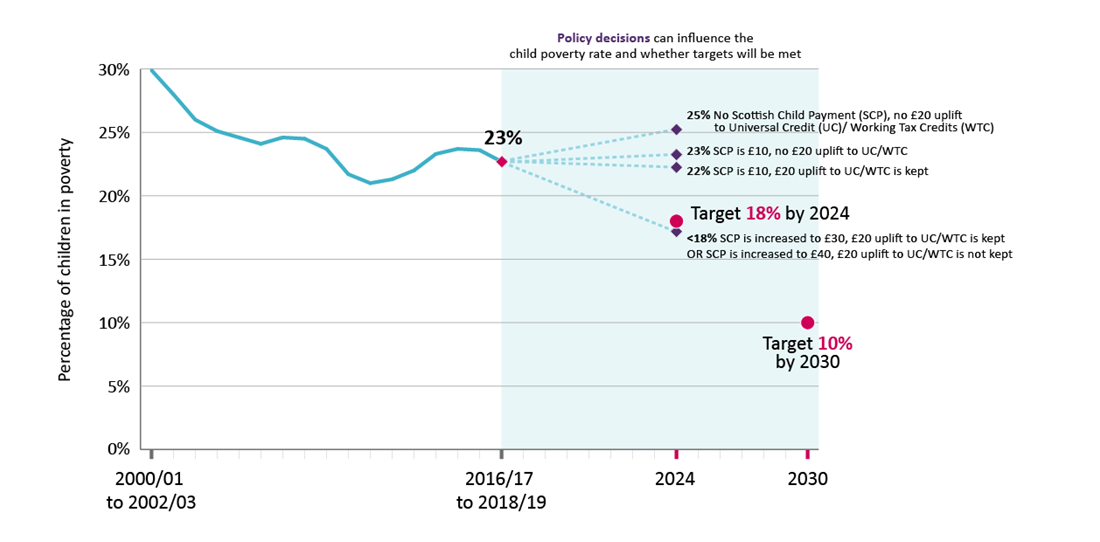Scotland's child poverty targets are possible - with political confidence and urgency
Parties in the upcoming Scottish election must make bold commitments to loosen poverty’s grip on many thousands of children – not just to meet targets, but to free childhoods from the damaging pressures of growing up in hardship.
It is possible with political courage and compassion, says Chris Birt, and our new analysis shows how.
This May’s election is a vital moment for the 1 million people, and almost a quarter of a million children, who are caught in poverty in Scotland. The Scottish Parliament was absolutely right to set ambitious targets to significantly reduce child poverty, but we are currently on course to miss these targets. Our analysis shows how much there is to do, but more importantly that these targets could be met, through an increase to the Scottish Child Payment and by keeping the lifeline of the £20 uplift to Universal Credit.
Why it’s crucial that we meet these targets
None of us want to see more children growing up in households struggling to pay the bills, weighed down by the anxiety of insecure incomes and an inadequate social security system. Children in poverty, along with their families, face damaging stigma that erodes their confidence and mental health, and leads to discrimination in workplaces and public services.
Scotland’s ambition is rightly for our children to grow up loved, safe and respected so that they realise their full potential. COVID-19 has shone a harsh light on the reality that for too many children this is not their experience. For many families, returning to normal will be little comfort when even before the pandemic every day was a struggle to make ends meet.
Where we are now
We are three years away from the interim milestone of reducing relative child poverty in Scotland to less than 18%. Today the rate is almost 1 in 4 (24%) and while the Scottish Child Payment should prevent this from rising, we still need to unlock at least 40,000 children from poverty by April 2024 to stay on track (or 50,000 if the recent uplift to Universal Credit is removed). Clearly this leaves us with much to do to meet the main target to reduce the rate to less than 1 in 10 children living in poverty by 2030.
Each of the parties has agreed to these targets and there has been welcome progress in the last Parliamentary Term. For example, this month sees the first payments of the Scottish Child Payment, a vital statement of the Scottish Parliament’s commitment to support families who need it the most. The full rollout of the new disability assistance benefits should also show us how to put people at the heart of our social security system. This progress should not be overlooked, and its momentum must be maintained.
The need for action
The analysis that we’re publishing today shows that each of the parties’ manifestos will have to significantly raise ambitions to meet the Parliament’s targets. It underlines that meeting those targets requires political confidence and urgent action. People caught in poverty need to see bold decisions; commitment to long-term change and confidence that it is possible. If we don’t take action, we will miss these targets.
Our analysis:
- projects that without further action, we will miss our interim target by around 4% - locking 40,000 children in poverty.
- underlines the importance of keeping the £20 uplift to Universal Credit – without this lifeline 10,000 more children will be left in poverty – leaving us 6% short of our target.
Significantly reducing child poverty in Scotland is possible
Our analysis also shows the art of the possible. A theoretical increase of the Scottish Child Payment to £30, assuming that the lifeline is kept, would meet the interim target at the cost of around £380 million a year. This equates to an investment of around 1% of the Scottish Government’s annual revenue budget for day-to-day spending prior to the pandemic.
If the £20 lifeline is cut by the UK Government, to meet the interim target the Child Payment would need to rise to £40, costing £520 million per year, closer to 1.5% of the same budget.
Clearly these are large sums of money and would require significant reprioritisation of Scottish Government spending or tax increases to pay for them. But neither are they unthinkable. In the last Parliament we have seen significant increases in NHS spending, additional funds for closing the attainment gap, and the expansion of universal childcare and early-learning provision.
It is of course vital to people across Scotland and the UK that the £20 lifeline is maintained, but if it is not, it is still incumbent on the incoming Scottish Government to meet the targets the Scottish Parliament has set for it. While the responsibility for cutting hundreds of millions of pounds from social security will lie with the UK Government, people in poverty in Scotland will need the Scottish Government to step up.
Projected trajectories for the child poverty rate under different scenarios
We have the means to solve child poverty in Scotland
Ultimately the key to solving poverty is adopting measures that we know will pull people out of poverty.
But let’s not kid ourselves. While meeting the interim target is theoretically possible via the child payment alone, we will not meet the 2030 targets without a major change in direction. As the job market recovers, we must ensure that work once again becomes an effective route out of poverty. It’s not right that two thirds of children in poverty live in a household where someone works. Low pay, inflexible conditions and unreliable hours are a trap that we must break people out of.
Similarly, we need action to address the affordability of housing. We can’t accept a situation where too many children are living in households that spend over 30% of their income on housing (80% of such children are in poverty). Again, a return to ’normal’ in low-income households will not be good enough.
We believe that attempting to meet these targets through social security alone is not the most sustainable and impactful way of doing so. Clearly raising people’s incomes is key but good work and affordable housing have the power to transform people’s lives as well as increasing their income, so a balance of interventions is better. We will set out our thinking on a more balanced set of solutions in the coming weeks.
Time for Scotland’s parties to step up to the challenge
Failure to meet these targets would be a failure to act on injustice in Scotland, an outcome that the million people in Scotland in poverty would pay a high price for. Instead, we must build a better Scotland, the Scotland children want to see while they're growing up. Simply put, none of us should be without the basics, we should be able to lead full and rewarding lives.
It is vital that each of the parties in this election embrace this challenge. Each step towards these targets, takes us closer to solving poverty in Scotland, but the time for incremental change is up. If we don’t act decisively and immediately, we will let our children down.

This idea is part of the child poverty topic.
Find out more about our work in this area.

